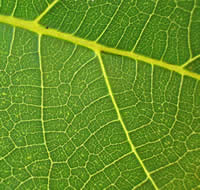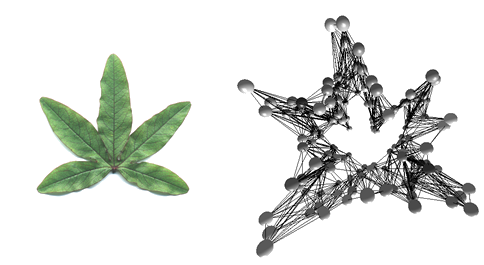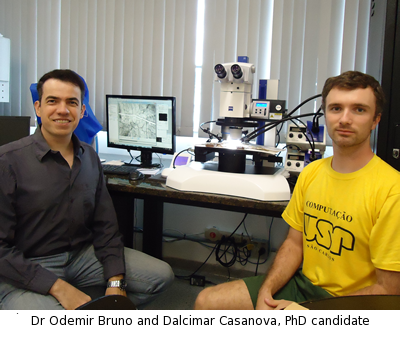Research group from IFSC is the reference in pattern recognition of plants
by IFSC - Communication Office
IFSC's researchers got the first position in ImageClef Plants, an international contest promoted by the French Society of Botany. The Imageclef was created in 2003, and launches annually contests for the global community involved in the area of pattern recognition. Usually, two types of contests are issued to each edition: the first is related to the problem of medical image identification, an important field which can lead the development of computer programs capable of seek tumors or to aid the analysis of diseases, and the second related to general images. Try to imagine if you could do a Google search for images from other images. For instance, you insert a picture of a car, and your Google search returns images of cars very similar. Would not it be great? Well, this system does not exist yet, but the work of the IFSC's scientists is to identify unique characteristics of certain objects so that, with a picture, you can access your information.
 In 2010, a new category of the contest was opened: the recognition of plants. Plant identification is a big challenge for the science due to the variability of their shape, which is much greater than the animal biology, eg. "That's when we came the question, " says Professor Odemir Bruno, supervisor of doctoral candidates Dalcimar Casanova and João Florindo, who joined the team ImageClef 2011. "Can we develop a computer system that recognizes all species of plants in Europe?" Added the professor.
In 2010, a new category of the contest was opened: the recognition of plants. Plant identification is a big challenge for the science due to the variability of their shape, which is much greater than the animal biology, eg. "That's when we came the question, " says Professor Odemir Bruno, supervisor of doctoral candidates Dalcimar Casanova and João Florindo, who joined the team ImageClef 2011. "Can we develop a computer system that recognizes all species of plants in Europe?" Added the professor.
The data set provided by the ImageClef on the internet, contained several photographs of many plant species native to Europe. According to Bruno, this is a theme that its collaborators have been trying to investigate for over ten years: "The idea is precisely to join Physics, Mathematics and Computing for analyzing biodiversity through images, perhaps for this reason have gone out to advantage". The work is a partnership with the Campinas Agronomic Institute (IAC), with the Escola Superior de Agricultura Luiz de Queiroz (Esalq - USP) and the UNESP of Assis. The researchers were concerned mainly with the shape, texture (standard leaf pigments) and innervation to establish a data set that would serve as recognition points on the image to the recognition of the species. With this, the team achieved a hit rate of almost fifty percent, above other competing institutions.
However, the European flora is very simple compared to the Brazilian flora, which is the richest in the world, which become less labored the proposal of a mathematical method for the identification of plants available.

"Our goal is to identify the Brazilian biodiversity, which is much more challenging than the European biodiversity" reflects the professor. More specifically, the researcher's thinking is that, even Sao Paulo State which is ecologically devastated and very developed, there is not a complete catalog its plant species. "If the Atlantic Forest is unknown to us in the state, then imagine the Amazon," he compares. "We are destroying without knowing what can be there, for instance, in one of the plant of the Amazon could be a potential cure for cancer". For this reason, the idea is to find a way to make a rapid forest survey. This kind of tool could also be used to analyze physiological and evolutionary phenomena which may dictate the best climate, best solo, best environment for the plant growth. "Mathematical modeling of plants can make us understand them much more," he explains. An example is a research project that gave rise to a system that checks the nutritional deficiencies of corn. In this system, with a hand scanner and a computer, the farmer can access all product information that is growing.
 The professor says that in a future research project, we can wonder a biologist investigating a forest with a smart phone. He could take a picture of a plant and get the plant species name, in a practical and fast way. Today, to identify a plant species found in a forest, a biologist should consult a herbarium, where dried plants are cataloged for many years - a process that can take many days. In this sense, the research project is a considerable facilitator and a great need for the science and also for the market.
The professor says that in a future research project, we can wonder a biologist investigating a forest with a smart phone. He could take a picture of a plant and get the plant species name, in a practical and fast way. Today, to identify a plant species found in a forest, a biologist should consult a herbarium, where dried plants are cataloged for many years - a process that can take many days. In this sense, the research project is a considerable facilitator and a great need for the science and also for the market.
However, Bruno says the problem encountered in biology is extremely difficult and sophisticated: "We are working on this for ten years, but it is possible that within ten years we are still improving our solution to this problem, because currently neither Mathematics, Physics and Computer Science have tools ready to solve it". Therefore, the team uses this problem to try to develop algorithms related to these research areas, in other words, every step toward the solution of the problem is a step ahead in Mathematics, Physics and Computer Science as well. These ideas are a guide to the researchers from the IFSC, could be possible some day to make a catalog of a forest using a mobile computer such as a tablet or a notebook ?

